| Mont Saint-Michel The booklet of the album |
Home + news | PAGES EN FRANÇAIS Châteaux de la Loire | Mont Saint-Michel Brocéliande | Icônes | International Press A Secret World | Destinations |
| Mont Saint-Michel The booklet of the album |
Home + news | PAGES EN FRANÇAIS Châteaux de la Loire | Mont Saint-Michel Brocéliande | Icônes | International Press A Secret World | Destinations |
| Here, you can discover the booklet of the Mont Saint-Michel album. Texts: © NathalieHureau - Miniatures: © HervéThibon English translation: Catherine Roussey |
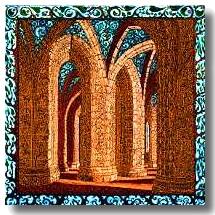 |
The
crypt of the Large Pillars
It was a time of war between France
and England. The Abbot of Mont Saint-Michel defected to the enemy, the
town was besieged and, to crown it all, in 1421, the choir of the Romanesque
church had collapsed. Reconstruction had to be done later, at the end of
the hostilities. Another century, another style. Gothic followed Romanesque,
vines followed the purity of the lines, and the resulting union stood the
test of time. But how to raise a stone more than 40 metres high? A gigantic
base, called the Crypt of the Large Pillars, was erected in 1446 to support
the new choir of the church. Nowadays, in this subterranean forest where
light is cloistered, the stone trunks have legendary dimensions. The strength
of their base which takes the shape of a colossal cluster of trees, is
very impressive. |
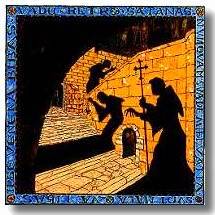 |
A
night in the abbey
The monks walked under a cold moonlight.
They moved slowly. The gravel crunched under their feet. During the dark
hours, while the doors of the church were closed, they recited a psalmody
: Vade Retro Satanas, Numquam Suade Mihi Vana ; Sunt Mala Quae Libas, Ipse
Venena Bibas. (Withdraw Satan, never advise me what is conceited. The beverage
you serve is evil, drink your own poison). It is said that entering the
church was forbidden as this was the hour when the angels sang. They sang
marvellous songs and a light brighter then the sun slowly filled up the
church. The incandescence was such that no living creature could penetrate
it without dying. |
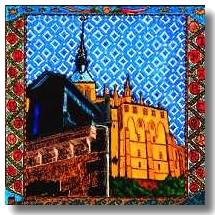 |
Theme
of the pilgrim
The pilgrim walked. He set off banner
ahead, with a beggar's bag and a calabash. Named Miquelet, he followed
the "Paths to heaven" which cut across France and led to Mont
Saint-Michel. In the Middle Ages, even children would join the pilgrimage.
They were under twelve years old and had left their parents to gather in
thousands in spontaneous processions. Pilgrims came from many different
countries. They went through towns and villages. In all weathers, through
many winds, they kept on walking. Sustained by their faith, they moved
on, full of hope. Each step was a step nearer from the sea. Even before
they could hear the murmur of the waves, the tall black outline of Mont
Saint-Michel would come into sight, rising up from the pasture land like
a mirage. |
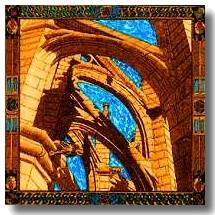 |
Gothic
gargoyles and lace
Out of reach for the one who hasn't
got wings, the gargoyle leans forward towards the world below. Sarcasm
pours out of its mouth. Like a bestiary of heights, a crowd of weird beings
clings to a mineral flora rooted in the powerful bulk of the stone. Creepers,
flowers and corollas cover the buttresses, the pinnacles and the flying
buttresses. The lacy granite rises up towards the light. Elegance, harmony,
virtuosity. The choir of the church, fruit of the profound science of gothic
architecture, was erected in the 15th century (1420-1521) onto the ruins
of the tumbledown Romanesque choir. The exhilaration of the true gothic
style brings the chevet to a new life. The stone darts towards the sky,
suspended, longing for soaring. |
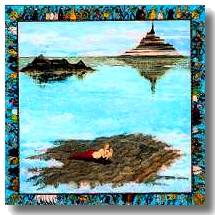 |
Quicksands
The slow tremolo of strings heralded
the floodtide of the ever moving sea. Guided by the song of oboes, a group
of pilgrims returned to the coast over the tidal flats. Among them was
a pregnant woman. They made their way through the hard and wrinkled "paumelles"
(sand flats). But how insidious was the sea! The water was overtaking them,
the water rose, the water licked the sands. The men hurried. The woman
was left behind, caught in the whirlpools of the rising sea. At this very
moment, the sword of the archangel stopped the waves. Saint Michel protected
the woman who was giving birth in the cold sand and wind. When the floodtide
receeded, they were still alive and the baby was christened Peril. Is it
a true story or just a legend? It is said that a cross was erected in this
spot, in memory of the miracle of the tidal flats' new mother. |
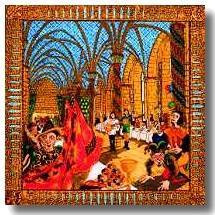 |
A
feast in the Guest Hall
Kings, Queens and generous donors were
welcomed by big feasts in this room lavishly decorated with tapestries,
stained glass and glazed tiles. Although it is quite lacking of ornamentation
at present, the Guest Hall is still the most handsome room of the six which
compose"La Merveille", erected in only twenty five years time
(1203-1228). Architectural feat, La Merveille is the material representation
of spiritual elevation. The rhythm of its composition is achieved through
figures and symbols. Three is the Trinity symbol. Three flights on the
rockside. Mastered balance of the stone. Seven is a perfect figure. Each
room has seven vaults, symbolizing totality. Seven, uncommon rhythm chosen
for this dance, evokes the magic of forgotten festivities. |
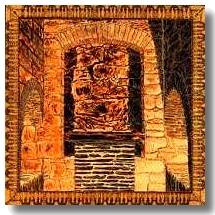 |
In
the crypt of Notre-Dame-Sous-Terre
The pre-Romanesque church, built on
the ruins of the primitive oratory is recalled by the simplicity of the
leitmotiv played on a classical guitar. Abbot Mainard and the twelve Benedictines
settled there in 966. The rectangular chapel with its massive stonework
nearly two metres thick, was transformed into a crypt during the building
of the Romanesque church. Nowadays, one can enter it through a long flight
of stairs which seems to descend into the heart of the universe. Forgotten
for a long time and even obstructed, Notre-Dame-Sous-Terre is buried in
the primeval heat of the earth. Even in the depth of winter, heat oozes
up, warm and motherly. In the deepest part of this sanctuary, behind a
small altar, one discovers the exposed rock of the initial Mont Tombe.
|
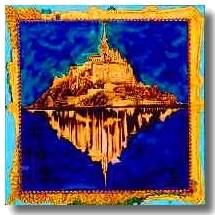 |
Immensi
Tremor Oceani
The leading theme of the album is defined
on one hand by the bass of the organ and the arpeggios of the synthesizer,
on the other hand by voices taking up the motto of the knights of Saint
Michel's Order : Immensi Tremor Oceani, dread of the vast ocean... This
Order, reserved for the noblest knights, was founded in 1469 by Louis XI,
who was an ardent pilgrim of Mont Saint-Michel. This Order was supposed
to compete with the famous Golden Fleece. Thirty six knights took the oath
of protecting, supporting and defending the Royal Crown. They wore long
coats of white damask with ermine and embroidered shells edgings and around
their necks, heavy golden medals bearing the effigy of the archangel. The
Script-Room of Mont Saint-Michel, where the monks were performing their
copying task, was given the name of Knight's Hall although the Order was
never really based there. |
|
|